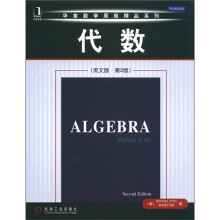华章数学原版精品系列:代数(英文版·第2版)
作者:(美)阿廷 著
出版:机械工业出版社 2012.1
页数:543
定价:79.00 元
ISBN-13:9787111367017
ISBN-10:7111367014
去豆瓣看看 Preface
1 Matrices
1.1 The Basic Operations
1.2 Row Reduction
1.3 The Matrix Transpose
1.4 Deternunants
1.5 Permutations
1.6 Other Formulas for the Determinant
Exercises
2 Groups
2.1 Laws ofComposition
2.2 Groups and Subgroups
2.3 Subgroups of the Additive Group of Intege
2.4 Cyclic Groups
2.5 Homomorphisms
2.6 Isomorphisms
2.7 Equivalence Relations and Partitions
2.8 Cosets
2.9 Modular Arithmetic
2.10 The Correspondence Theorem
2.11 Ptoduct Groups
2.12 Quotient Groups
Exercises
3 VectorSpaces
3.1 SubspacesoflRn
3.2 Fields
3.3 Vector Spaces
3.4 Bases and Dimension
3.5 Computing with Bases
3.6 DirectSums
3.7 Infinite-DimensionalSpaces
Exercises
4 LinearOperators
4.1 The Dimension Formula
4.2 The Matrix of a Linear Transformation
4.3 Linear Operators
4.4 Eigenvectors
4.5 The Characteristic Polynomial
4.6 Triangular and DiagonaIForms
4.7 JordanForm
Exercises
5 Applications ofLinear Operators
5.1 OrthogonaIMatrices and Rotations
5.2 Using Continuity
5.3 Systems ofDifferentialEquations
5.4 The Matrix Exponential
Exercises
6 Symmetry
6.1 Symmetry ofPlane Figures
6.2 Isometries
6.3 Isometries ofthe Plane
6.4 Finite Groups of Orthogonal Operators on the Pl
6.5 Discrete Groups oflsometries
6.6 Plane Crystallographic Groups
6.7 Abstract Symmetry: Group Operations
6.8 The Operation on Cosets
6.9 The Counting Formula
6.10 Operations on Subsets
6.11 Permutation Representations
6.12 Finite Subgroups ofthe Rotation Group
Exercises
7 More Group Theory
7.1 Cayley's Theorem
7.2 The Class Equation
7.3 Groups
7.4 The Class Equation of the IcosahedraIGroup
7.5 Conjugationin the Symmetric Group
7.6 Normalizers
7.7 The Sylow Theorems
7.8 Groups ofOrder12
7.9 TheFreeGroup
7.10 Generators and Relations
7.11 The Todd-Coxeter Algorithm
Exercises
8 BilinearForms
8.1 BilinearForms
8.2 SymmetricForms
……
9 Linear Groups
10 Group Representations
11 Rings
12 Factoring
13 Quadratic Number Fields
14 Linear Algebra in a Ring
15 Fields
16 Galois theory
Michael Artin,当代领袖型代数学家与代数几何学家之一,美国麻省理工学院数学系荣誉退休教授。1990年至1992年,曾担任美国数学学会主席。由于他在交换代数与非交换代数、环论以及现代代数几何学等方面做出的贡献,2002年获得美国数学学会颁发的Leroy P.Steele终身成就奖。Artin的主要贡献包括他的逼近定理、在解决沙法列维奇-泰特猜测中的工作以及为推广“概形”而创建的“代数空间”概念。
《华章数学原版精品系列:代数(英文版·第2版)》是作者在代数领域数十年的智慧和经验的结晶。书中既介绍了矩阵运算、群、向量空间、线性算子、对称等较为基本的内容,又介绍了环、模型、域、伽罗瓦理论等较为高深的内容。本书对于提高数学理解能力,增强对代数的兴趣是非常有益处的。此外,本书的可阅读性强,书中的习题也很有针对性,能让读者很快地掌握分析和思考的方法。
作者结合这20年来的教学经历及读者的反馈,对本版进行了全面更新,更强调对称性、线性群、二次数域和格等具体主题。本版的具体更新情况如下:
新增球面、乘积环和因式分解的计算方法等内容,并补充给出一些结论的证明,如交错群是简单的、柯西定理、分裂定理等。
修订了对对应定理、su2 表示、正交关系等内容的讨论,并把线性变换和因子分解都拆分为两章来介绍。
新增大量习题,并用星号标注出具有挑战性的习题。
《华章数学原版精品系列:代数(英文版·第2版)》在麻省理工学院、普林斯顿大学、哥伦比亚大学等著名学府得到了广泛采用,是代数学的经典教材之一。









 缺书网
缺书网 扫码进群
扫码进群